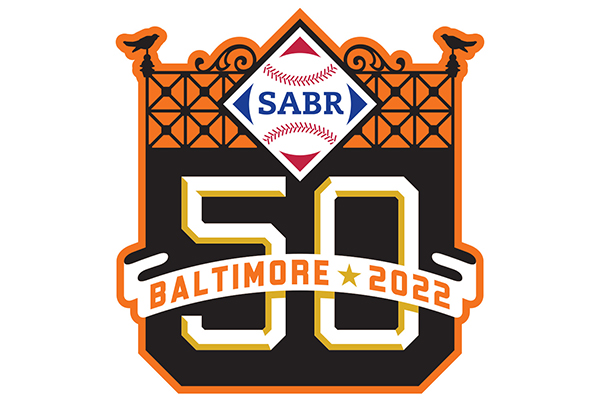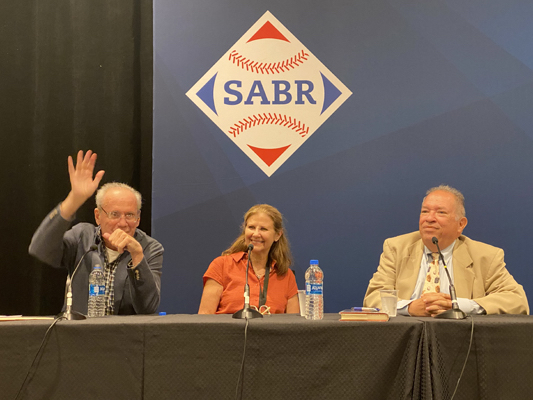SABR 50: Listen to highlights from Ballparks Panel with Larry Lucchino, Janet Marie Smith, and Charles Steinberg
At SABR 50 on August 20, 2022, the SABR Ballparks Committee hosted a special panel discussion on Oriole Park at Camden Yards.
Panelists included former Baltimore Orioles president Larry Lucchino, acclaimed ballpark design director Janet Marie Smith, and longtime baseball executive Charles Steinberg, who spoke about the construction and design of Camden Yards, which set the standard for a new wave of ballparks after its opening in 1992. The panel was moderated by SABR CEO Scott Bush.
- Audio: Click here to listen to the SABR 50 Ballparks Panel (MP3; 58:20)
Here are more highlights:
On the beginning of demands for a new stadium in Baltimore
- Steinberg: “(Baltimore) Mayor (William Donald) Schaefer — later Governor Schaefer — had the political leadership. He was gonna drive this and he said to Larry, ‘You just build the best damn ballpark there’s ever been, and I’ll take care of the politics.’ But the mood had been set much earlier, even before (Edward) Bennett Williams bought the club (in 1979). 1971 was an important year in prehistoric times. The Orioles suffered 14 rainouts in 1971. It was such a blemish on the season, despite being the third straight year we won the pennant, that the cover of the 1972 media guide was the cartoon bird holding an umbrella with rain falling on it. It was a major story. The Orioles could not survive with 14 rainouts a year. … In August 1972, there’s a story with the headline “Balto-dome.” And the idea that we needed a new stadium was really starting to simmer because of the rain in ‘71 and because here we were, the best team in baseball, and we’re not selling out the World Series.”
On how the Colts inspired the building of Camden Yards
- Lucchino: “When the Colts left town (in 1984), it kind of lit the fire that said, ‘There will be a new ballpark’ because we cannot afford to have two teams leave Baltimore. One team, maybe we can live with, but the Orioles, who were part and parcel of the fabric of Baltimore at the time — by 1984 we were well-established, we had won the World Series in ’83, we had captured the spirit and the imagination of the town in the early ’80s — and people couldn’t imagine Baltimore without the Orioles and the Colts. So the governor (William Donald Schaefer) did his job and appointed a task force to examine possibilities for new sites and we started looking in earnest.”
On the struggles of sharing Memorial Stadium with the Colts
- Smith: “Obviously, the field configuration is wildly different, and with the round parks, whether you were seated on the 50-yard line or whether you were seated between the baselines, because of that round configuration you were about as far away from the center of action as possible — the opposite of what you want to be. And the size was always compromised, too. Baseball historically wants to be a 40,000-ish number and football wants a 60- to 65,000-ish number, so when you design for the football capacity, except for a playoff game or Opening Day, it never felt alive.”
On the early search for a new stadium location
- Lucchino: “We looked at several places between Baltimore and Washington that might be available. So right from the get-go, (Orioles owner Edward Bennett) Williams was determined to have a new ballpark that would fuel his dreams for the Orioles. And it took a while to get around to the sites, to be sure, and to get around to the name took another long while. But the fact is that it was … a recognition of the inadequacy of Memorial Stadium.”
On designing Camden Yards
- Smith: “One of the things that was magical about this building was that it was part of the definition of the Inner Harbor, or it had a chance to redefine and expand the definition of the Inner Harbor. And if you roll back the tape and think about Baltimore at the time, in the early 1980s the waterfront was created as a promenade, a park, Ralph’s Pavilion, the (Hyatt Regency) hotel we’re sitting in, the (National) Aquarium, the science center — all of these things that happened under Mayor William Donald Schaefer’s watch — created what today we think of as an urban entertainment center. … And this idea of putting the ballpark downtown on this site, walking distance from all these other attractions, was a very high priority for then-governor William Donald Schaefer. He famously said, ‘Well, go ahead and do your study, I don’t care what it says, as long as it says put it downtown.’ ”
On the Orioles’ response to feedback on Camden Yards
- Steinberg: “Larry and Janet Marie had a collaborative vision and effort, and the humility to know that they did not know every aspect of the fan experience as felt by the fans. So let’s go back to 1989, 1990: there are fan plan meetings taking place here in Baltimore. Larry, Janet Marie, [and] Julie Wagner of the Orioles coordinated them, 25 people sitting around [as they asked] repeatedly, ‘What do you want? What do you need? What would make the experience better for you?’ And three of the top songs that people sang: more ladies’ restrooms, larger ladies’ restrooms, cleaner ladies’ restrooms, with a shelf for your purse.’ Now I’ll speak for Larry — he didn’t know a lot about ladies’ restrooms. Neither did I. But just listen to the people.”
Transcription assistance by Emma Yanai.
For more coverage of SABR 50, visit SABR.org/convention.
Originally published: September 12, 2022. Last Updated: September 13, 2022.



